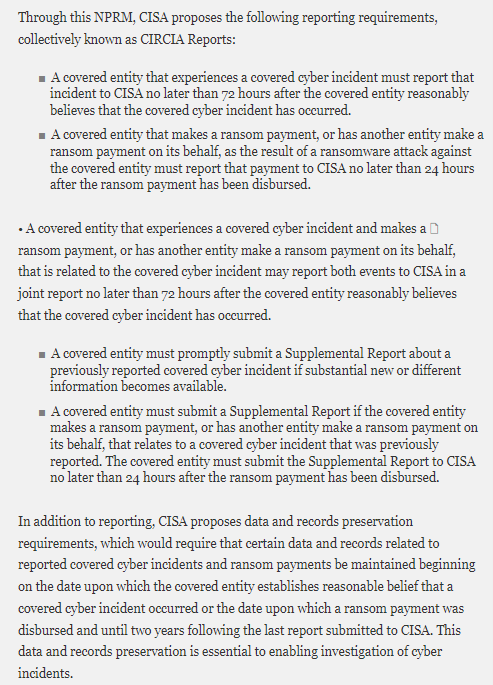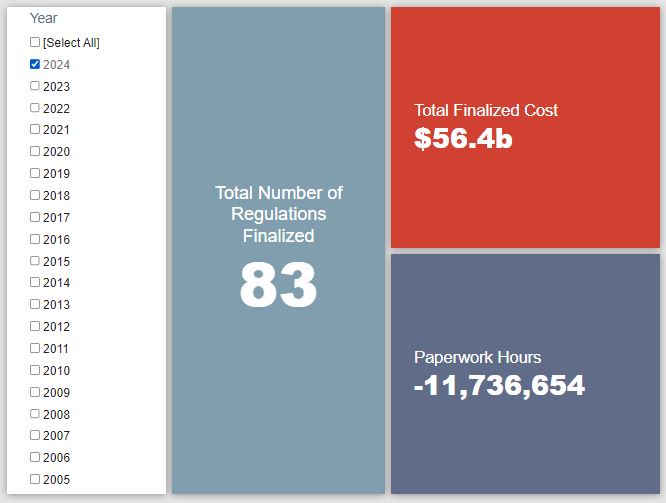Week in Regulation
April 8, 2024
Medicaid Streamlining Rule Pushes Regulatory Totals in Diverging Directions
Last week was certainly a busy one in the pages of the Federal Register. There were 15 rulemakings with some measurable economic impact, the most consequential of which was the rule from the Department of Health and Human Services (HHS) seeking to streamline the application process “for Medicaid, the Children’s Health Insurance Program (CHIP), and the Basic Health Program (BHP).” While the rule included sizable reductions in administrative burdens, its resulting increase in costs for state-level budgets pushed Biden-era regulatory costs to a new level. Across all rulemakings, agencies published $23 billion in total costs but cut 24.9 million annual paperwork burden hours.
REGULATORY TOPLINES
- Proposed Rules: 24
- Final Rules: 62
- 2024 Total Pages: 24,299
- 2024 Final Rule Costs: $56.4 billion
- 2024 Proposed Rule Costs: $33.7 billion
NOTABLE REGULATORY ACTIONS
The most significant rulemaking of the week was the HHS rule regarding “Medicaid Program; Streamlining the Medicaid, Children’s Health Insurance Program, and Basic Health Program Application, Eligibility Determination, Enrollment, and Renewal Processes.” The rule makes a host of changes that seek to make it easier for individuals to either enroll or re-enroll in the relevant health programs. It comes on the heels of a similar rule from last September that focused on such reforms in the Medicare Savings Program. All told, HHS expects this rule to reduce the overall paperwork burdens on enrollees by nearly 27.3 million hours annually. In making the process easier, however, HHS also expects the enrolled population to grow substantially. While the federal government will pick up most of that tab, state governments can expect to be on the hook for more than $23 billion in spending above a pre-rule baseline. That total minus the monetized administrative savings nets out to roughly $20.3 billion in total costs that the American Action Forum (AAF) tracks for RegRodeo.
TRACKING THE ADMINISTRATIONS
As we have already seen from executive orders and memos, the Biden Administration will surely provide plenty of contrasts with the Trump Administration on the regulatory front. And while there is a general expectation that the current administration will seek to broadly restore Obama-esque regulatory actions, there will also be areas where it charts its own course. Since the AAF RegRodeo data extend back to 2005, it is possible to provide weekly updates on how the top-level trends of President Biden’s regulatory record track with those of his two most recent predecessors. The following table provides the cumulative totals of final rules containing some quantified economic impact from each administration through this point in their respective terms.![]() The Medicaid/CHIP streamlining rule discussed above accounted for most of the movement in the Biden Administration’s to-date final rule tallies, with cost surging by more than $21 billion but paperwork declining by 27.2 million hours. This increase in the cost total is particularly notable, however. Not only does it push the Biden-era regulatory record past the half-trillion-dollar mark, it also means that the current administration has already exceeded the entire first-term total of $493 billion in costs published during the Obama Administration. While there was a seismic shift in the Biden tallies, the other two administrations saw only nominal changes during the respective first weeks of April in 2012 and 2020.
The Medicaid/CHIP streamlining rule discussed above accounted for most of the movement in the Biden Administration’s to-date final rule tallies, with cost surging by more than $21 billion but paperwork declining by 27.2 million hours. This increase in the cost total is particularly notable, however. Not only does it push the Biden-era regulatory record past the half-trillion-dollar mark, it also means that the current administration has already exceeded the entire first-term total of $493 billion in costs published during the Obama Administration. While there was a seismic shift in the Biden tallies, the other two administrations saw only nominal changes during the respective first weeks of April in 2012 and 2020.
THIS WEEK’S REGULATORY PICTURE
This week, the Department of Homeland Security (DHS) proposes some new cybersecurity standards for critical infrastructure operations. Source: Photo by Sigmund on Unsplash
Source: Photo by Sigmund on Unsplash
Last Thursday, DHS published a proposed rule entitled “Cyber Incident Reporting for Critical Infrastructure Act (CIRCIA) Reporting Requirements.” As the title suggests, the proposal comes under the auspices of the Cyber Incident Reporting for Critical Infrastructure Act of 2022 and seeks “to promulgate regulations implementing the statute’s covered cyber incident and ransom payment reporting requirements for covered entities.” In particular, the rulemaking seeks to establish a reporting and data retention process for “covered entities.”
The rulemaking’s primary requirements are described thusly: DHS estimates that roughly 316,000 installations or facilities will fall into the category of “covered entity.” These range from various communications apparatuses to energy transmission infrastructure to entities involved in the security of sensitive national security and financial data. DHS expects total industry implementation costs to reach roughly $1.4 billion over a 10-year horizon, with the largest share falling to entities that provide “Operationally Critical Support to the Department of Defense or Processes, Stores, or Transmits Covered Defense Information.”
DHS estimates that roughly 316,000 installations or facilities will fall into the category of “covered entity.” These range from various communications apparatuses to energy transmission infrastructure to entities involved in the security of sensitive national security and financial data. DHS expects total industry implementation costs to reach roughly $1.4 billion over a 10-year horizon, with the largest share falling to entities that provide “Operationally Critical Support to the Department of Defense or Processes, Stores, or Transmits Covered Defense Information.”
Notably, while the main thrust of this rulemaking involves establishing requirements for industry reports and data retention practices – items that would typically fall under the purview of the Paperwork Reduction Act (PRA) – this rulemaking is exempt from the PRA’s reach thanks to language in the CIRCIA. Nevertheless, based on calculations from data in the agency’s cost estimate section, one can expect the direct filing of the relevant reports to involve more than 916,000 hours over the 10-year analytical period, or nearly 92,000 hours annually.
Interested parties have until June 3, 2024, to submit comments on the proposal.
TOTAL BURDENS
Since January 1, the federal government has published $90.2 billion in total net costs (with $56.4 billion in new costs from finalized rules) and 8.6 million hours of net annual paperwork burden increases (with 11.7 million hours in reductions coming from final rules). 










